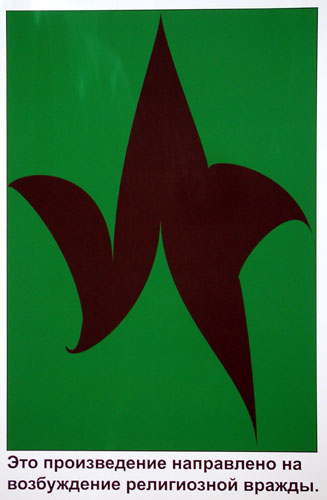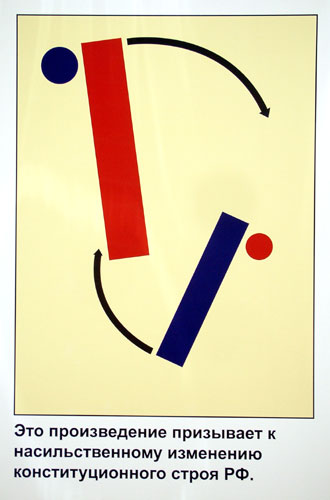 David Riff
Ter-Oganian’s Real Object of Ridicule
David Riff
Ter-Oganian’s Real Object of Ridicule
The whole story looks like another episode of the same old soap opera. Once again, the Russian Ministry of Culture is refusing to bring contemporary art to France. This time, it is a series of graphics called “Radical Abstractionism” by Avdei Ter-Oganian that was supposed to be shown at an exhibition at the Louvre. “The Ministry of Culture and the Russian Cultural Protection Agency didn’t let out these works because of their content,” said NCCA general director Mikhail Mindlin. They had an “unfriendly and provocative quality” and would incite political scandal and religious discord. In particular, Mindlin cites the combination of green and black in a piece overtly-ironically labelled as a provocation of hatred against Islam.
Several prominent participants of the exhibition have already reacted to this latest outburst of censorship: artists Yuri Albert and Diana Machulina have written open letters in which they announce that they are boycotting the exhibition unless Ter-Oganian’s work is included, and further open letters are rumored to follow. In that sense, something has changed. Artists have begun to politicize the conditions of their work, making use of their right to refuse participation. As Diana Machulina puts it, they are protesting not only this concrete case but “the triumph of ideological censorship that has beset the Russian Federation, along with the desire to prevent any possibility of irony or critique.”
So why were these particular works censored? “In connection with their content,” says Mikhail Mindlin, and by that he means the work’s textual dimension. Content is defined as the immediate presence of “unfriendly and provocative” topics, as a collection of keywords in an html metatag. It’s the mere mention of Islam, prostitution, or the Russian constitution that offends. A certain combination sets off a McCarthyist alarm. It is exactly this kind of tripwire reaction that the artist wants to provoke, showing how the managerial-administrative logic of the state rests upon stupid binary procedures that ignore the real content of the piece.
Because the real content of this particular series by Ter-Oganian is a little more complex. It is “offensive,” no doubt, but not to Muslims, Jews, or Russian Orthodox believers. Actually, the real object of his critique is art and the figure of the artist, as is almost always the case in his work. The whole point of this particular series is that there is a huge gap between the accusatory caption (an inverse image of the artwork’s political claim) and the image in question. They are clearly at odds, like in Magritte’s “Ceci n’est pas une pipe.” That is, if one looks at the pictures themselves, they are not radical; one sees very little that might be inflammatory, except for iconic colors, or the schematic snout of a pig. These pictures are funny because they are impotent; that is, they are so “abstract” that even a superficial political reference uncoded through accusation cannot rouse anything but a smirk.

So, Avdei Ter-Oganian’s point is not just to make fun of over-vigilant bureaucrats. He also wants to ridicule contemporary art’s tendency to couch politics in opaque “abstractions” that, once named, serve as symbols of a critique they no longer perform. That is an old problem from the heyday of modern art in the early-to-mid 20th century, and one that became relevant again in the mid-2000s, when many former radical artists all over the world made a turn toward “formalism,” aestheticism, and the autonomy of art without ever relinquishing the radical claim of their work. In Moscow, one of the first battle cries of that turn was “abstraction,” called out by Anatoly Osmolovsky, formerly one of the most radical artists of the 1990s. Though the term was soon abandoned (it sounds naive), a more neutrally post-minimalist version of “urban formalism” came to dominate the Moscow art scene, always maintaining the claim of being secretly politically radical. Now, as a crisis-hardened bourgeoisie seeks to discard the remnants of glamor, and as the state looks to visualize its ideology of nano-modernization, that local brand of ‘political minimal’ looks more and more attractive as a new official language. But only as long as “content” remains safely hidden in the folds of form. When this kind of art is challenged and censored, when its content is named and revealed, its own political claim collapses. As the ridiculous and even ornamental pictures of Ter-Oganian’s “Radical Abstractionism” show. By engaging in self-censorship through abstraction, former radicals prove that reality itself is far more radical than any of their forms. Ter-Oganian reveals this as a self-cancellation that collapses into stupidity. Now not just in art, but in real life.
This essay was originally published in Russian on Openspace.ru: http://www.openspace.ru/art/events/details/18016/.
Images © Avdei Ter-Oganian / http://www.guelman.ru. The captions on the works read, respectively, as follows: “This work is designed to incite religious hatred,” and “This work calls for the violent overthrow of the constitutional regime of the Russian Federation.”



